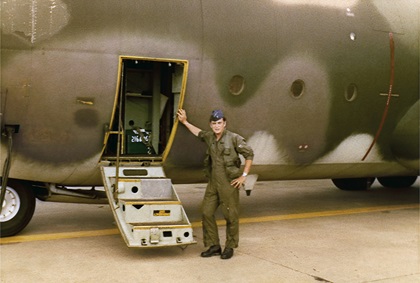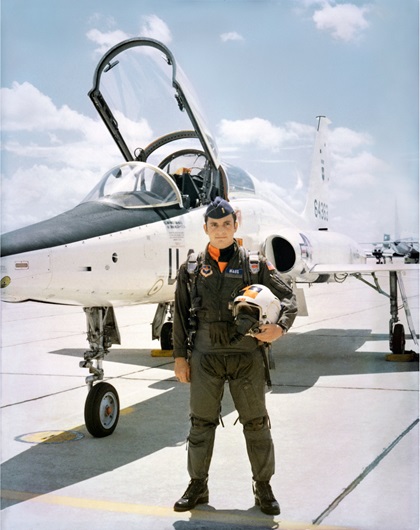Rust removal in progress
Former Air Force pilot finds his place in GA
Two years ago former U.S. Air Force pilot Stephen Maus wondered if there might be room in general aviation for someone who had flown heavy military aircraft in far-away war zones more than four decades ago.
“They said sure, send us two dollars and we will send you your plastic certificate,” he said.
After Maus’s six-year Air Force hitch as a pilot in Vietnam and other parts of southeast Asia, and later in Europe, and from Dyess Air Force Base in Texas, Maus had gone to graduate school, and launched a financial-services career.
Aviation had become part of his past. But it hadn’t vanished from his consciousness altogether, thanks to a long-standing friendship with John McKenna Jr., of Bozeman, Montana, chairman of the Recreational Aviation Foundation, a Cessna 185 owner, and active GA pilot.
 When Maus told McKenna of the two-dollar investment in a new plastic pilot certificate, McKenna suggested a logical follow-up. Maus should attend an AOPA Rusty Pilots seminar that was scheduled near Maus’s home in the Dallas/Fort Worth area.
When Maus told McKenna of the two-dollar investment in a new plastic pilot certificate, McKenna suggested a logical follow-up. Maus should attend an AOPA Rusty Pilots seminar that was scheduled near Maus’s home in the Dallas/Fort Worth area.
“I signed up,” Maus said in a phone interview. “I think there were a hundred people there.”
Maus confessed to feeling out of place in that big crowd of GA aviators. The self-consciousness abated as he took in the session presented by Pat Brown, the 2013 FAA Houston District and Southwest Regional Flight Instructor of the Year and an AOPA You Can Fly program ambassador who Maus said he found to be “really engaged” with his presentation, and with the audience.

What also helped Maus start enjoying himself was realizing that the basic body of aviation regulations, the “norms and altitudes” of aviation, were as he remembered them.
“I was pleasantly surprised that I was not as far behind as I might be,” he said. “I was intrigued by what I already knew/remembered, but also how technology changes.”
It was natural that a few months later, Maus decided to find out whether his piloting skills had withstood time as well as his book knowledge had.
Investigating that question put him in the cockpit of an American Champion Decathlon—after C-130s it was like flying a kite, he said—with a flight instructor who was soon able to inform Maus that he still had the touch. Maus’s own reaction to his first time flying the tailwheel-equipped light single after a career piloting heavy military aircraft was no different than any other pilot’s might be: “Aerobatics are easier than landing that little guy!”

With his comeback to aviation gaining lift, Maus went for an FAA medical exam. The visit went well, and he walked out of the doctor’s office with a second class medical certificate in his pocket.
Two more steps would put Maus firmly within the ranks of rusty pilots who have made good a return to flying.
One was to get some time flying a glass-cockpit-equipped Diamond DA40 single-engine airplane, to get used to new-generation avionics.
“This was really, really foreign to me,” he said.
The next goal was to find an airplane that he and his wife, and perhaps two other passengers could fly in from the high-elevation environment of Bozeman, Montana, where they spend much of their free time—and where the McKennas occupy the hangar next door—to destinations in the backcountry, or to airports best handled in an airplane with good high-density-altitude performance.
In January 2017, Maus found the ship he was looking for: a 2004 Cessna T182T Turbo Skylane outfitted with a Garmin G1000 avionics suite.
As of mid-June 2017 Maus had accumulated about 100 hours flying the Turbo Skylane. He describes the aircraft as a “good solid airplane with a good track record” that puts some of the challenging runways he would like to land on safely within reach—a goal that also had sent him to another Pat Brown presentation at a safety symposium in Addison, Texas, on backcountry flying.
Maus said he has flown “all over Montana,” and recently was planning a trip to Idaho’s Smiley Creek Airport, elevation 7,206 feet msl, and he was seeking other flight destinations, possibly including a two-aircraft outing to the Big Bend in west Texas this fall.

Maus said he has found that the return to flying has come to mean more to him than simply the satisfaction of dusting off stale skills and expanding the options for recreation. Becoming a member of the GA community also has offered him a way to disassociate the idea of flying from some of the imagery connected with flying in war.
“Thanks for helping get an ole AF guy back to doing something fun,” he wrote in a recent email to AOPA.
Most pilots who have stopped flying because of cost, time, or regulations plan to get back into flying. AOPA created the Rusty Pilots program to lower the barrier to re-entry and provide lapsed pilots a way to return to flying in a matter of hours. Rusty Pilots seminars are hosted across the country and satisfy the ground portion of the flight review. Nearly 40 percent of those who attend a Rusty Pilots seminar complete their flight review and return to the air as pilot in command.




